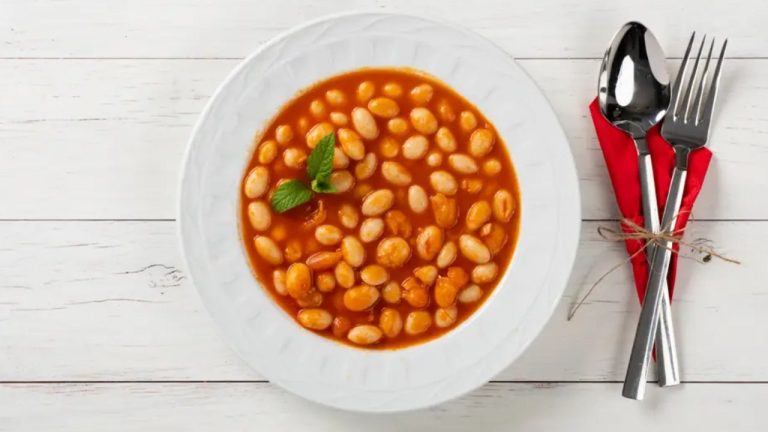Kuru Fasulye, a traditional Turkish bean stew, is a beloved dish that holds a special place in Turkish cuisine. This hearty and nutritious meal is enjoyed by people of all ages and is a staple in many Turkish households. The dish is known for its comforting and rich flavors, making it a perfect choice for family dinners and gatherings. Often served with rice (pilaf) and a side of pickled vegetables (turşu), Kuru Fasulye is not only delicious but also a symbol of Turkish culinary heritage.
History of Kuru Fasulye
The origins of Kuru Fasulye can be traced back to the Ottoman Empire, where beans were a common ingredient in many dishes due to their nutritional value and versatility. The use of beans in Turkish cuisine likely increased during the 17th and 18th centuries when the Ottoman Empire expanded its culinary influences and incorporated new ingredients and techniques from its vast territories.
Kuru Fasulye gained widespread popularity in Turkey due to its simplicity and the availability of its ingredients. White beans, tomatoes, and onions are staples in the Turkish pantry, making this dish accessible to people from all walks of life. Over time, regional variations of Kuru Fasulye have emerged, with some areas adding meat, while others prefer a vegetarian version.
This humble yet flavorful stew has been a part of Turkish food culture for centuries and remains a favorite comfort food. It is commonly found in Turkish restaurants and homes, and its preparation is often passed down through generations, preserving the authentic taste and tradition.
Today, Kuru Fasulye continues to be cherished not only in Turkey but also among Turkish communities around the world. It stands as a testament to the rich culinary history of Turkey and the enduring appeal of simple, hearty, and delicious food.
Dry Bean Stew Recipe Ingredients:
2 cups dried white beans (cannellini or navy beans)
1 large onion, finely chopped
2 cloves of garlic, minced
2 medium tomatoes, peeled and diced (or 1 can diced tomatoes)
2 tablespoons tomato paste
1-2 green peppers, chopped (optional)
1 teaspoon red pepper paste (optional)
1 teaspoon of red pepper
1 teaspoon ground cumin
Salt and pepper to taste
3 tablespoons olive oil or vegetable oil
6 cups of water or vegetable broth
1-2 dried bay leaves (optional)
Fresh parsley, chopped (for garnish)
Instructions:
Prepare the Beans:
Sort and rinse the dry beans. Soak in plenty of water overnight or for at least 8 hours. Drain and rinse the beans before cooking.
Cook the beans:
Place the soaked beans in a large saucepan and cover with fresh water. Bring to the boil, then reduce the heat to low and simmer for about 1 hour or until the beans are tender but not falling apart. Drain and set aside.
Prepare the base:
In the same pot or a large saucepan, heat the olive oil over medium heat. Add the chopped onions and sauté until translucent, about 5-7 minutes.
Add the minced garlic and green peppers (if using) and cook for another 2-3 minutes.
Add the Tomatoes and Spices:
Stir in the diced tomatoes (or canned tomatoes), tomato paste and chili paste (if using). Cook for about 5 minutes, allowing the tomatoes to break down and the flavors to meld together.
Add the paprika, ground cumin and bay leaves (if using). Season to taste with salt and pepper.
Combine Beans and Sauce:
Add the cooked beans to the pot and mix well with the tomato mixture.
Pour in the stock or vegetable broth, making sure the beans are well coated. Bring to a boil.
Bring to a boil:
Reduce the heat and let the stew simmer gently for about 30-45 minutes, or until the flavors meld and the sauce reaches your desired consistency. Stir occasionally to prevent sticking and ensure even cooking.
Final Adjustments:
Taste and adjust seasoning with more salt, pepper or spices if needed. If the stew is too thick, you can add a little more water or broth.
Serve:
Serve the beans hot, garnished with freshly chopped parsley.
Traditionally served with rice (pilaf) and pickles or fresh salad.
Tips:
For a richer flavor, you can add a small piece of beef or lamb when cooking the onions.
If you prefer a spicier dish, increase the amount of red chili paste or add some chili flakes.
The dish can be kept in the refrigerator for up to 3 days and usually tastes better the next day as the flavors continue to develop. Enjoy your meal!

